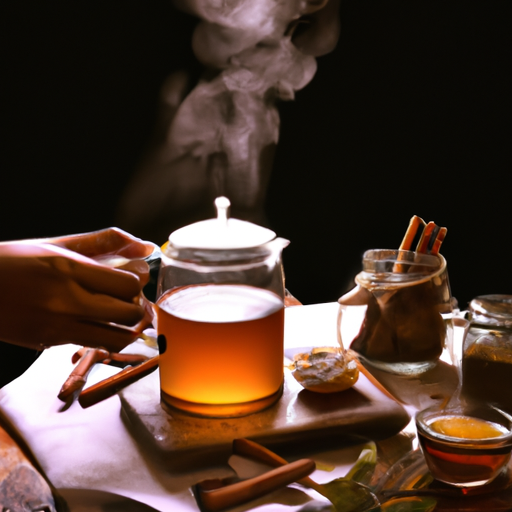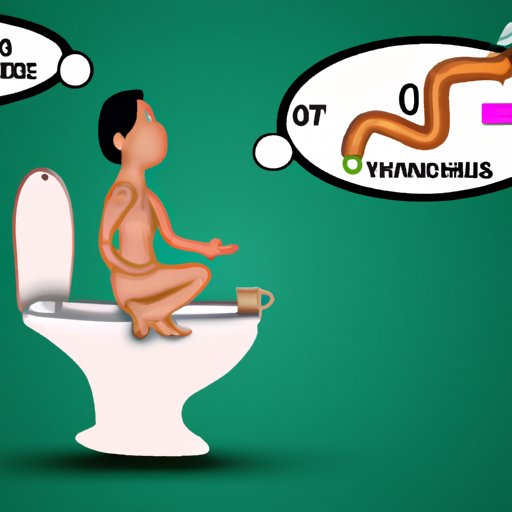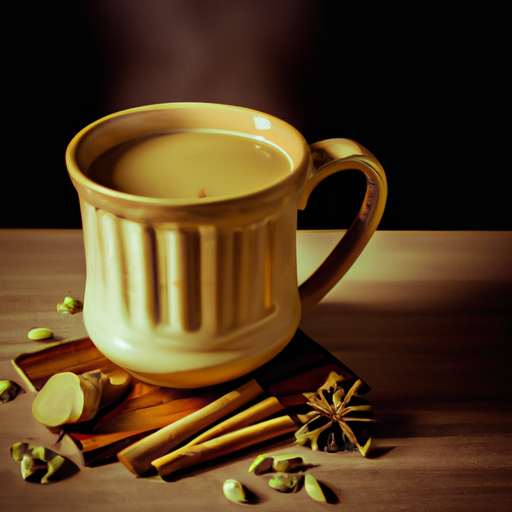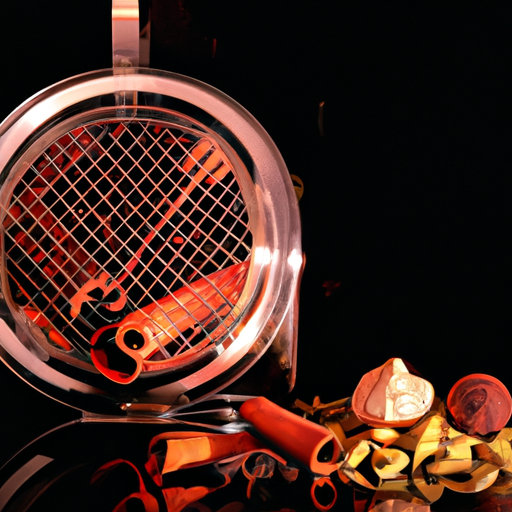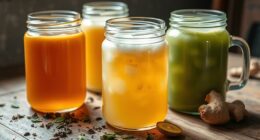Imagine this scenario: You enter a welcoming Starbucks during a brisk fall day, greeted by the fragrant aromas of aromatic spices and rich vanilla floating around. You place an order for your go-to beverage, a piping hot chai tea latte, and have a taste. The luxurious mix of black tea, cinnamon, cardamom, ginger, and clove mingles flawlessly on your palate, offering both comfort and a revitalizing sensation simultaneously.
Now imagine being able to recreate that same experience at home. With just a few simple steps and ingredients, you can make your own delicious chai tea just like Starbucks – no need to leave the comfort of your own kitchen.
In this article, I’ll guide you through each step of the process so you can enjoy this delightful drink any time you want.
So let’s get started!
Key Takeaways
- Using high-quality loose leaf black tea is essential for an authentic flavor like Starbucks’.
- Spices like cinnamon, cardamom, and cloves can be added for an extra kick.
- Pay attention to water temperature and steeping time to achieve the perfect cup.
- Experiment with different variations and pairings to find your preferred flavor profile.
Understanding Chai Tea
So, you’re wondering what exactly chai tea is and why it’s so darn delicious? Let’s break it down for you.
Chai tea is a traditional Indian beverage that is made by steeping black tea with spices such as cinnamon, cardamom, ginger, cloves, and black pepper. The word ‘chai’ actually means ‘tea’ in Hindi, which means that when we say ‘chai tea,’ we are essentially saying ‘tea tea.’
The history of chai tea dates back to thousands of years ago when Ayurvedic healers in India began using the spices found in chai to promote good health. Over time, the recipe evolved into the deliciously spiced beverage that we know and love today.
In India, chai is more than just a drink; it holds cultural significance and is often shared among friends and family during social gatherings.
Now that you understand what chai tea is all about, let’s move on to choosing the right type of tea for your homemade version.
Choosing the Right Tea
When it comes to choosing the right tea, there are a few key factors that I always consider.
Firstly, I think about whether I want to use loose leaf or tea bags – both have their pros and cons.
Secondly, I decide whether I’m in the mood for black tea or green tea. Each has its own unique flavor profile and health benefits.
Finally, it’s important to remember that not all teas are created equal – so do your research and choose high-quality options whenever possible!
Loose Leaf vs. Tea Bags
If you want to replicate the chai tea from Starbucks, using loose leaf tea instead of tea bags will give your drink a more authentic taste and aroma. Loose leaf teas are made up of whole or large pieces of tea leaves that retain their natural oils and flavors. This means that when steeped in hot water, they release a full-bodied flavor profile that is more complex than what you get from pre-packaged tea bags. In contrast, most commercial tea bags contain fine particles of broken tea leaves and dust which can result in a weaker brew with less depth.
To help illustrate the difference between loose leaf versus bagged teas, here’s a simple table:
| Loose Leaf Tea | Tea Bags | |
|---|---|---|
| Quality | Made up of whole or large pieces of tea leaves which retain natural oils and flavors. Results in a fuller bodied flavor profile. | Contain fine particles of broken tea leaves and dust which can result in a weaker brew with less depth. |
| Convenience | Requires extra equipment such as an infuser or strainer but worth the effort for the superior taste. | Convenient for on-the-go brewing but may not provide the best quality cup due to smaller size and lower quality. |
When it comes to making chai, using loose leaf black tea will be key to achieving an authentic flavor like Starbucks’. However, if you’re looking for something lighter and less caffeinated, substituting green tea could be another option worth exploring.
Black Tea vs. Green Tea
You may be surprised to learn that the type of tea you choose can greatly impact the flavor and health benefits of your chai. Black tea, the traditional base for chai, is known for its bold and robust flavor. It contains antioxidants that help reduce inflammation in the body and improve heart health.
On the other hand, green tea has a lighter and more floral taste compared to black tea. It also offers various health benefits such as reducing the risk of certain cancers and aiding in weight loss.
To fully enjoy your homemade Starbucks-style chai, here are some tips:
- Experiment with different types of tea to find your preferred flavor profile
- Steep your chosen tea properly to extract all its flavors
- Consider adding spices like cinnamon or cardamom for an extra kick
- Use high-quality loose leaf tea for a richer taste
- Don’t hesitate to mix black and green teas together for a unique blend of flavors
Now that you have an idea about which type of tea suits your preference best, it’s time to gather all the necessary ingredients for our delicious chai recipe.
Gathering Ingredients
First, grab the black tea bags and whole spices – did you know that chai is the most popular type of tea in India? For me, this means going to my local grocery store and picking up a few essential ingredients. Here are some ingredient substitutions and shopping tips to keep in mind:
| Ingredient | Substitution |
|---|---|
| Black tea bags | Green tea bags |
| Cardamom pods | Ground cardamom |
| Ginger root | Ground ginger |
When it comes to shopping for ingredients, I always try to find high-quality products. Look for loose leaf black tea or high-quality tea bags without any added flavors or sweeteners. For whole spices like cinnamon sticks, cloves, and cardamom pods, I recommend buying them in bulk so you can use as much or as little as needed.
Once all the ingredients are gathered, it’s time to move onto preparing the spices.
Preparing the Spices
Now, it’s time to spice things up! Let’s dive into preparing the aromatic spices that’ll give your chai its signature flavor. First, we need to toast the spices to bring out their natural oils and enhance their fragrance. This is an important step in making chai tea as it gives the drink a rich and warm aroma.
To toast the spices, simply heat a small skillet over medium-low heat. Once hot, add whole cloves, cinnamon sticks, cardamom pods, and black peppercorns. Toast them for 2-3 minutes until fragrant, but be careful not to burn them. The key here is toasting them just enough to release their flavors.
After toasting the spices, let them cool down before grinding them into a fine powder using a spice grinder or mortar and pestle. This step is crucial as freshly ground spices will give your chai tea a more intense flavor compared to pre-ground ones from the store.
Now that our spices are ready, let’s move on to brewing the tea itself. By following these simple steps of toasting and grinding our spices, we’ve created a flavorful base for our chai tea that’ll transport us straight into an authentic Indian experience. Next up is brewing the tea with milk and sweetener for a perfect balance of spicy sweetness.
Brewing the Tea
When brewing chai tea at home, it’s important to pay attention to the water temperature and steeping time in order to achieve the perfect cup.
I usually bring the water to a boil and then let it cool for about 1-2 minutes before pouring it over the tea bags or loose leaf tea.
Steeping time can vary depending on personal preference, but I typically let my chai tea steep for around 3-5 minutes before removing the tea bags or straining out the loose leaf tea.
Water Temperature
Well, it’s not like you need to be a rocket scientist to know that boiling water is way too hot for making chai tea like Starbucks.
Boiling point water can damage the tea quality, releasing bitter compounds and destroying delicate flavors.
The ideal water temperature for chai tea is around 190-200 degrees Fahrenheit, which means that the water should be heated until it simmers gently but doesn’t boil vigorously.
This temperature range allows the tea leaves to steep properly, resulting in a rich and complex flavor profile.
To get this right, you can either use a thermometer or rely on your senses to determine when the water is ready.
If using a thermometer, make sure to insert it into the pot before heating up the water and remove it as soon as you reach the desired temperature.
Alternatively, you can observe the bubbles forming at the bottom of the pot they should be small and steady rather than large and violent.
Once your water reaches its sweet spot, turn off heat and move on to steeping time.
Now that we have our perfect temperature set for brewing chai tea like Starbucks let’s move onto another crucial aspect – steeping time.
Steeping Time
To get the perfect taste, you’ll want to steep your tea for around 3-5 minutes. However, this is just a general guideline and it’s important to experiment with different steeping times to find the perfect balance of flavor. Steeping tea for too long can result in a bitter taste while not steeping it enough can result in a weak and watery chai.
Timing is crucial when it comes to making chai tea like Starbucks. The ideal duration of steeping time varies depending on the type of tea leaves used and personal preference. For instance, black tea requires longer steeping time compared to green or white teas. It’s essential to observe how the color changes as well as the aroma intensifies during each minute of brewing until you achieve your desired strength.
Now that we’ve covered the importance of timing, let’s move on to adding the spices which will give our chai its signature flavor.
Adding the Spices
Now that we’ve brewed the tea, it’s time to add those delicious spices that make chai so special. The key to achieving the perfect balance of flavors is in getting your proportions just right.
I usually add about a teaspoon of cinnamon, cardamom, and ginger each, but feel free to adjust according to your taste preferences. And don’t forget about cooking time – letting the spices simmer for too long can result in a bitter taste, so be sure to keep an eye on it!
Proportions
For a perfectly balanced chai tea like Starbucks, mix equal parts of water and milk in a saucepan with black tea bags and your desired amount of chai spices. Measuring accurately and adjusting ratios is key to achieving the right flavor profile for your taste buds. Experimenting with different spice blends can also add an extra dimension of complexity to your drink.
To ensure consistency, use measuring cups or a kitchen scale when mixing the water and milk. A 1:1 ratio is standard, but you can adjust it based on personal preference. When it comes to adding the chai spices, start with small amounts and gradually increase until you find the perfect balance.
Here are three tips to keep in mind when experimenting with spice blends:
- Cinnamon adds sweetness and warmth.
- Ginger provides a spicy kick.
- Cardamom offers floral notes.
Once you have achieved the desired proportions for your chai tea, it’s time to move onto cooking time where we’ll bring all these ingredients together over heat for maximum flavor infusion.
Cooking Time
During the cooking time, you’ll want to keep an eye on your chai tea mixture like a hawk guarding its nest, ensuring that it doesn’t boil over and create a mess on your stovetop. It’s important to maintain a steady heat throughout the entire process, so be sure to stir the mixture occasionally with a whisk or spoon. This will ensure that all of the spices and flavors are evenly distributed throughout the liquid.
As you wait for your chai tea mixture to come to a simmer, it’s important to practice patience. Don’t rush the process by turning up the heat too high or stirring too vigorously. Instead, use a gentle stirring technique and allow the spices to release their full flavor over time.
With patience and attention to detail, you’ll soon have a delicious pot of homemade chai tea ready for sweetening!
Sweetening the Tea
To make your chai tea like Starbucks, don’t forget to add a touch of sweetness with some honey or sugar. While Starbucks uses classic syrup as their sweetener, you can experiment with alternative sweeteners such as agave nectar or stevia for a healthier twist. The key is to balance the sweetness so it doesn’t overpower the spice blend in the tea.
When adding honey or sugar to your chai tea, start with a small amount and gradually increase until you reach your desired level of sweetness. Keep in mind that too much sugar can make the tea overly sweet and detract from its complex flavor profile. If using honey, stir it into the hot tea until fully dissolved before adding any additional sweeteners.
Now that you’ve added some sweetness to your chai tea, it’s time to move on to adding milk for that creamy finish. Simply heat up some milk of your choice and pour it into your chai mixture for a deliciously indulgent treat.
Adding Milk
Now that we’ve covered how to make the perfect chai base, it’s time to talk about adding milk.
As someone who loves a good latte, I know that not all milk is created equal. Depending on your personal taste and dietary restrictions, there are a variety of milk options to choose from – including dairy-free alternatives like almond or oat milk.
It’s also important to consider the amount of milk you want in your chai – whether you prefer a creamy latte or just a splash for added flavor.
Types of Milk
For a creamy and indulgent chai tea like Starbucks, try using steamed whole milk instead of skim or almond milk. While almond milk and soy milk are popular dairy-free options for those who prefer to avoid traditional milk, they often lack the richness and creaminess that whole milk provides. Whole milk contains more fat than its low-fat counterparts, making it perfect for creating a velvety texture in your chai tea.
If you’re looking to make a truly decadent chai tea at home, then whole milk is definitely the way to go. However, if you still want to keep things on the lighter side, you can use 2% or even 1% milk instead of skim. The amount of fat in these alternatives will be enough to create a satisfyingly creamy consistency without adding too many extra calories.
With your choice of milk now sorted out, let’s move on to discussing the correct amounts of each ingredient needed to make the perfect cup of chai tea!
Amounts
You’ll want to use just a pinch of ground black pepper in your homemade chai to add a subtle kick and complement the other warm spices. Measuring accurately is key when making chai, as it requires a delicate balance of ingredients. Adjusting ratios can make all the difference in achieving the perfect flavor profile.
To start, measure out your desired amount of water and tea leaves. As a general rule, you’ll want to use one teaspoon of loose leaf tea or one tea bag per eight ounces of water. Next, add your desired amount of spices such as cinnamon, cardamom, ginger, and cloves. A good starting point is 1/4 teaspoon each per cup of water.
Finally, add milk (or a non-dairy substitute) and sweetener to taste. Experiment with different amounts until you find the perfect ratio for your taste buds.
Once you’ve achieved the ideal blend of flavors and spices in your chai tea mixture, it’s time to move on to creating foam for that signature Starbucks touch.
Creating Foam
Don’t be intimidated, creating the perfect foam for your homemade chai tea is easier than you think! While Starbucks uses a steam wand to create their signature foam, there are alternative methods that can achieve similar results.
One popular method is using a French press. Simply heat up some milk on the stove or in the microwave, pour it into the French press, and pump the plunger up and down until you have achieved your desired level of foam.
If you’re having trouble getting your foam just right, don’t worry! There are a few troubleshooting tips that can help. First, make sure your milk is fresh and cold before heating it up. This will help create more stable bubbles in your foam. Additionally, try not to overheat your milk as this can cause it to scorch and ruin the taste of your chai tea.
Now that you’ve created the perfect foam for your chai tea, it’s time to serve and enjoy! Pour your hot brewed chai tea into a mug and spoon some of the foamed milk on top. You can also sprinkle some cinnamon or nutmeg on top for added flavor.
Sit back, relax, and savor every sip of your homemade chai tea with deliciously frothy milk foam on top!
Serving and Enjoying
Now that I’ve created my perfect cup of chai tea, it’s time to talk about serving and enjoying it. Presentation is key when it comes to any beverage, and a well-crafted cup of chai deserves an equally impressive presentation.
When it comes to pairings, there are plenty of options that complement the rich flavors of chai tea, such as pastries or savory snacks. And for those who want to experiment with different tastes, there are endless variations on the classic recipe to try out.
Let’s dive into these aspects of serving and enjoying chai tea!
Presentation
Feeling fancy? Add some whipped cream and cinnamon on top of your homemade chai tea to impress your guests with a Starbucks-worthy presentation.
Chai tea presentation is important because it sets the tone for the entire experience. Here are four serving techniques that will elevate your chai tea presentation:
- Use a clear glass mug to showcase the beautiful color of the chai tea.
- Sprinkle ground cinnamon over the whipped cream for an added touch of flavor and elegance.
- Place a cinnamon stick in the mug as a stirring tool and garnish.
- Serve on a wooden tray along with some biscuits or cookies for an inviting and cozy atmosphere.
By taking these simple steps, you can turn an ordinary chai tea into a sophisticated beverage that will impress anyone who tries it.
Now, let’s move on to exploring some exciting pairings and variations to add some excitement to your chai tea experience!
Pairings and Variations
Looking to spice up your chai tea experience? Pair it with some delicious food! Chai tea goes well with many different types of snacks and desserts.
For a sweet pairing, try a cinnamon roll or a buttery croissant. The warm spices in the chai complement the sweetness of the pastry perfectly.
If you’re looking for something savory, consider pairing your chai with a classic grilled cheese sandwich or some spicy Indian samosas.
Another way to switch up your chai game is by experimenting with flavor variations. Vanilla extract can add a creamy twist to your classic chai, while almond milk gives it a nutty flavor and silky texture.
You could also try adding some honey or maple syrup for extra sweetness, or even infusing the tea with fresh ginger or cardamom pods for an added kick of spice. Whatever variation you choose, make sure to start with high-quality loose leaf tea and fresh ingredients for the best results.
Frequently Asked Questions
What are the health benefits of drinking chai tea?
As someone who enjoys a warm cup of chai tea, I’m happy to share the health benefits that come with this delicious beverage.
Chai tea is known for its high nutritional value and ability to promote overall wellness.
The blend of spices in chai, including cinnamon, ginger, and cardamom, have anti-inflammatory properties that can help reduce joint pain and lower the risk of chronic diseases like heart disease and diabetes.
Additionally, chai tea contains antioxidants that can boost immune function and improve digestion.
So if you’re looking for a tasty way to support your health, consider adding a cup of chai tea to your daily routine!
Can I use a different type of milk instead of cow’s milk for my chai tea?
I love experimenting with different types of milk in my chai tea, and I’ve found that almond milk is a fantastic alternative to cow’s milk. It adds a nutty flavor that complements the spices in the chai perfectly.
If you’re looking for a creamier option, soy milk can be a great substitution as well. Both alternatives are plant-based and can make your chai tea more suitable for those with dietary restrictions or preferences. Just remember to choose an unsweetened version to avoid overpowering the flavor of the spices.
Overall, don’t be afraid to try new things and find what works best for you when it comes to making your perfect cup of chai tea.
How long can I store the prepared chai tea in the fridge?
I’ve been wondering how long I can store my prepared chai tea in the fridge. After doing some research, I found that storing chai tea is similar to storing any other beverage.
The shelf life of prepared chai tea depends on how it’s stored and the ingredients used. Generally, refrigeration is recommended for preserving its freshness and taste quality. It’s best to consume within 2-3 days of preparation to avoid any health concerns or expiration dates.
If you want to extend its shelf life, you can freeze it in an airtight container, but there may be a slight change in taste when thawed.
Overall, it’s important to keep track of how long your chai tea has been stored and use your senses (such as smell or taste) to determine if it’s still good to drink.
Can I use pre-ground spices instead of whole spices for my chai tea?
Using pre-ground spices for chai tea can be a convenient option, but it also has its pros and cons.
On the one hand, pre-ground spices are readily available in most grocery stores, eliminating the need to hunt down whole spices. Additionally, they can save you time since you don’t have to grind them yourself.
However, using pre-ground spices may result in a weaker flavor compared to using whole ones since they lose their potency over time. To make the perfect chai tea with pre-ground spices, I recommend opting for high-quality brands and checking the expiration date before purchasing. It’s also essential to adjust the amount of spices depending on their age and quality to ensure that your chai tea is flavorful and aromatic.
Overall, while it’s possible to use pre-ground spices for your chai tea, it’s essential to keep in mind their limitations and take steps necessary to maximize their flavor potential.
Can I make a caffeine-free version of chai tea?
Yes, it’s possible to make a caffeine-free version of chai tea by using herbal alternatives such as rooibos or chamomile instead of black tea. These alternatives not only provide a different flavor variation but also offer a range of health benefits.
Rooibos, for example, contains antioxidants and can help improve digestion while chamomile has calming properties that can aid in relaxation. To make the caffeine-free version of chai, simply replace the black tea with your chosen herbal alternative and follow the same recipe for making traditional chai tea.
You can also experiment with different spices and sweeteners to create unique flavor combinations that suit your taste buds.
Conclusion
In conclusion, making chai tea like Starbucks isn’t as complicated as it may seem. With the right ingredients and a little patience, anyone can enjoy a delicious cup of this classic drink in the comfort of their own home.
Just like any other recipe, it’s important to understand the basics before starting. Choosing the right tea and gathering fresh spices are key components that can’t be overlooked.
Once you have all your ingredients, brewing the tea and sweetening it to taste will bring out all the flavors you’ve prepared. Adding milk and creating foam will give your chai that signature creamy texture we all know and love.
So go ahead and try making chai at home! It’s a fun activity that can easily become part of your routine. Who knows, maybe one day you’ll even surpass Starbucks’ version with your own unique twist.

